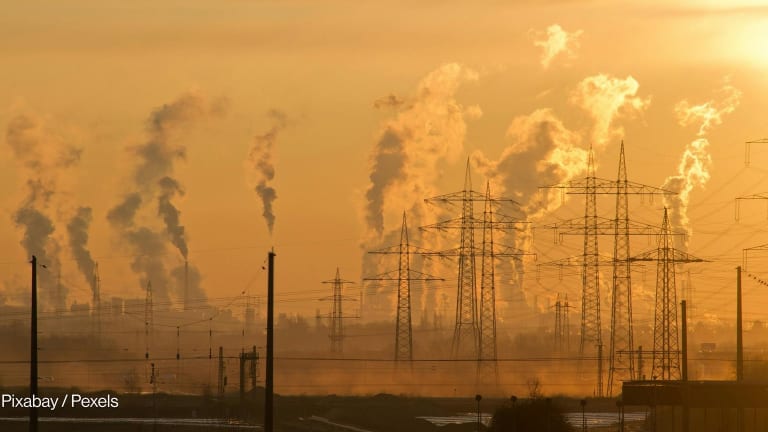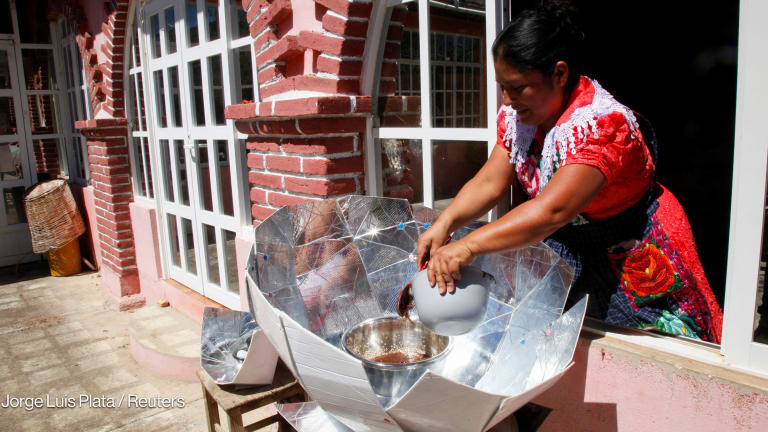
At COP 26, public health is a growing conversation. Air pollution, given its contribution to climate change, has been discussed widely. But the impact of air pollution, especially indoor pollution, that disproportionately affects women remains largely ignored.
Sign up for Devex CheckUp
The must-read weekly newsletter for exclusive global health news and insider insights.
Almost all of the global population — 99% — breathe in polluted air, according to the World Health Organization. A growing body of evidence suggests women are among the worst affected.
“Globally, air pollution is the fourth leading risk factor for deaths among females,” Pallavi Pant, a senior scientist who studies the health impacts of air pollution at the Boston-based Health Effects Institute, told Devex. Extended exposure to high pollution levels is linked to chronic heart disease, respiratory diseases, lung infections, lung cancer, diabetes, and other health problems.
As evidence of the public health impacts of air pollution has become clear, we have learnt that breathing in pollutants is linked to worsening maternal health outcomes. Air pollution has been found to push up rates of pregnancy loss and complications. The issue is particularly relevant to the developing world where the exposure levels are higher.
“We need more representation from women in the field of air quality so that their perspective is represented in platforms where decisions get made.”
— Pallavi Pant, senior scientist, Health Effects Institute“Over the past decade, a growing body of scientific evidence has indicated that women who are chronically exposed to particulate air pollution are more likely to have babies born too small [due to low birth weight] or too early,” Pant said.
And yet, while conversations on air pollution in the public discourse are centered on children and low-income households being the worst hit, women aren’t seen as being as vulnerable despite the mounting evidence.
Lack of political will
A study in India has shown that women are exposed to high levels of indoor air pollution, especially because they tend to be the primary caregivers and, in large parts of the world, are in charge of cooking for their families, which exposes them to high levels of indoor air pollution. “Especially in countries where families rely on solid fuels for cooking and heating, women tend to have very high exposures to pollutants such as PM2.5,” said Pant.
Fielding a question during a COP 26 side event about the reason for a lack of focus on women, Dr. Maria Neira, director for public health and environment at WHO, said, “It is not for a lack of evidence.”
“It is a lack of political will or blindness. I don’t know what to call it,” she said.
What is clear though is that women are ignored in the conversation, said Arpitha Kodiveri, a legal researcher focusing on issues of environmental justice at New York University’s School of Law. When they are spoken of, it is in the context of their role as mothers. For instance “scary ammis,” which translates to “scary mothers,” is a group in Pakistan that advocates for clean air for their children and has received attention for their advocacy.
“I think the invisibilization happens for two reasons. One, it's [air pollution] seen as a very generic issue affecting everybody. Two, the fact that women have generally been invisible in the broader environmental movement,” Kodiveri said.
Some of these issues are also to do with the patriarchy of the environmental movements that tend to be led by men, and that in turn affects how many of the issues play up, Kodiveri added. “The laws themselves don't identify women as a category of vulnerability or [show how] their rights are going to be severely impacted. Where we did see something like that emerge was in the land rights movement. As far as other environmental issues are concerned, women tend to find spaces in very particular defined areas,” she said.
It is important to address this issue as the carbon emissions of several countries in the developing world are likely to continue growing in the coming years before they peak, according to the Emissions Gap Report 2021 put together by the United Nations Environment Programme. Many of the pollutants that push global temperature to rise also cause air pollution, with the U.N. calling air pollution and climate change two sides of the same coin.
At the ongoing COP 26, the priority for the developing world is centered around demand for greater climate finance and technology transfer. India, home to the world’s most polluted region — the Indo-Gangetic plain — is set to go net-zero nearly four decades from now in 2070. But improving air quality would require the developing world to act nationally first as the sources of air pollution are local.
Need for women’s voices in policy
Climate change is compounding many of these health issues, according to Dr. Maria Guevara, international medical secretary at Médecins Sans Frontières. Speaking to Devex at COP 26, where MSF is present for the first time and explaining why public health ought to be in the main text of climate negotiations, she said, “Narratives matter, words matter.”
Guevara explained that in many parts of the world where MSF runs its projects, women are often in situations where they don’t have the agency to make decisions for themselves, which makes it important to focus on empowering them.
Speaking about a project in Nigeria, she said, “We did a survey, a knowledge, [and] attitude and practice survey, to understand what the behaviors were. The women don't have the capacity to decide for themselves. And so we had to reach out to the elderly women and to the husbands and discuss the value of health care for women.”
One of the ways to bring in more balance would be to include women at every stage of decision making, experts say.
It is important to bring attention to the high impact air pollution has on women’s health, said Pant, and identify ways to present and share scientific data, especially with communities where women have the highest exposures. This has to go hand in hand with interventions and programs to promote women’s engagement in decision making. “We need more representation from women in the field of air quality so that their perspective is represented in platforms where decisions get made,” Pant said.
Disha Shetty is attending COP 26 on a 2021 Climate Change Media Partnership, a journalism fellowship organized by Internews' Earth Journalism Network and the Stanley Center for Peace and Security. This story was produced as a part of it. Devex retains full editorial control of all content.









